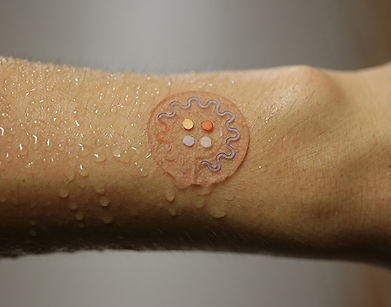
What's New
Controlling a Hand Exoskeleton With Your Mind
By Emily Waltz
Posted 7 Dec 2016 | 14:00 GMT
Researchers have developed a hand exoskeleton that can be controlled solely by thoughts and eye movements, according to a report published yesterday in the inaugural issue of Science Robotics. Six quadriplegic individuals tested the device in everyday situations; they successfully picked up coffee cups, ate donuts, squeezed sponges, and signed documents, the researchers reported.
Cheap, Rugged, Sweat-Sensing Skin Patch Hints at Bloodless Testing
By Jeremy Hsu
Posted 28 Nov 2016 | 14:25 GMT
Sweat could be the next thing wearable devices sense to track your health, researchers say. A new microfluidic skin patch capable of collecting and analyzing sweat has survived tests that included a grueling 104-kilometer bike race. And the next-generation wearable device has attracted the attention of companies such as cosmetics giant L’Oreal and a major sports beverage maker—not to mention the U.S. military. It could even pave the way for a painfree, bloodless method of prescreening people for diabetes in the future, according to its inventors.
The flexible sweat sensor collects sweat in a tiny tubing system as it’s worn against the skin. Different sections of the sensor slowly change color as they react to different levels of certain chemicals found within sweat. Any smartphone with the right app can take a picture of the sweat sensor to automatically interpret the color changes and biochemistry of the sweat as certain health signs. To tests the device’s ruggedness, volunteers even wore the sweat sensor during a long-distance, outdoor bicycling race.
“This is radically different from current-generation wearable devices that are a block of electronics strapped to the body,” says John Rogers, a physical chemist and materials scientist at the University of Illinois at Urbana-Champaign. “This allows a clinical-like precision measurement of health markers that physicians know how to interpret.”

The fact that the system functions outside the laboratory, in busy, unsupervised environments, is a dramatic improvement upon previous brain-controlled robotic limbs, says Surjo Soekadar, a neuroscientist and physician at the University Hospital of Tübingen in Tübingen, Germany. Soekadar led the study.
The system works by translating the brain’s electrical activity into actions in the robotic hand. The user, wearing a mesh cap with five electrodes, thinks about grasping an object. This produces a pattern of brain activity detected by electroencephalography, or EEG. An algorithm on a tablet computer identifies these specific brain activity patterns and translates them into control signals. A control box and set of actuators then commands the hand exoskeleton to carry out the set of coordinated movements that add up to the grasping motion.
The whole process—from intention to grasp—takes just over a second, says Soekadar. That’s probably not fast enough to catch a ball, but it’s suitable for picking up a cup or turning a knob. The hand exoskeleton itself was developed by Nicola Vitiello and Maria Chiara Carrozza at The BioRobotics Institute of the Scuola Superiore Sant’Anna in Pisa, Italy.
Rogers’ group has previously developed soft electronics such as flexible, dissolvable brain implants. In this case, they minimized the use of electronics in the skin patch to ensure that it could be resilient and cheap enough for one-time use. The details on their work with an international team of South Korean and Chinese collaborators appeared last week in the online edition of the journal Science Translational Medicine.
The biggest challenge in making the sweat sensor was balancing the softness, thinness, flexibility and comfort of the device with its functionality as a health sensor, Rogers explains. The researchers ensured that the device could create a water-tight seal with the surface of the skin so that it could remain in place during even the most high-intensity exercise.

